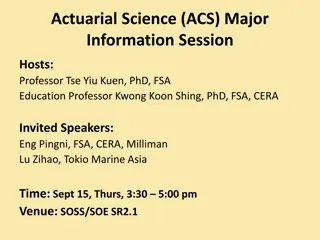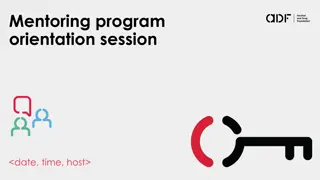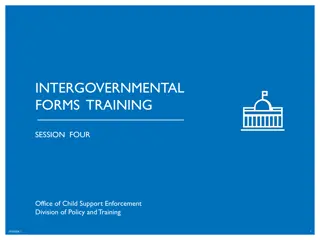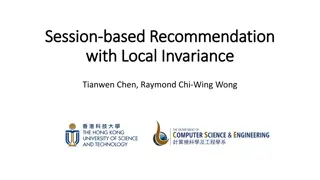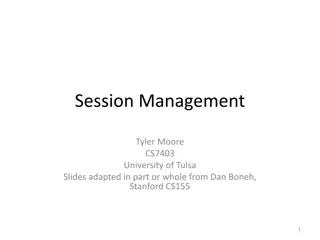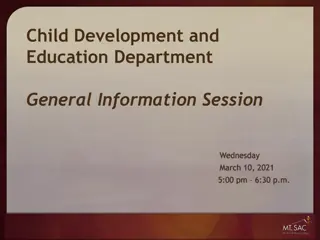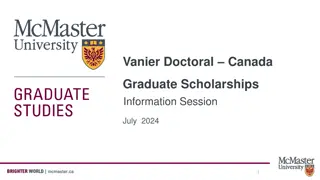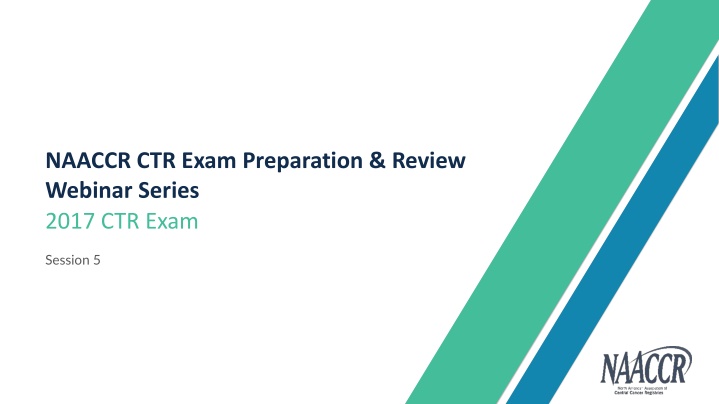
Effective Quality Control Strategies for Cancer Registry Data
Explore comprehensive strategies for quality control in cancer registry data, covering principles, practices, and tools to ensure accuracy and reliability. Learn about data quality assurance, process controls, acceptance sampling, and designed studies for optimal data management.
Download Presentation

Please find below an Image/Link to download the presentation.
The content on the website is provided AS IS for your information and personal use only. It may not be sold, licensed, or shared on other websites without obtaining consent from the author. If you encounter any issues during the download, it is possible that the publisher has removed the file from their server.
You are allowed to download the files provided on this website for personal or commercial use, subject to the condition that they are used lawfully. All files are the property of their respective owners.
The content on the website is provided AS IS for your information and personal use only. It may not be sold, licensed, or shared on other websites without obtaining consent from the author.
E N D
Presentation Transcript
NAACCR CTR Exam Preparation & Review Webinar Series 2017 CTR Exam Session 5
Resources Cancer Registry Management Principles & Practices for Hospitals and Central Registries, 3rd Edition Cancer Program Standards Ensuring Patient-Centered Care 2016 Edition https://www.facs.org/quality-programs/cancer/coc/standards 2
Data Quality Assurance 23 Questions
Quality Control of Cancer Registry Data Quality Fitness for use Quality control Planned set of activities to monitor quality Quality assurance Monitoring processes and methods to ensure quality 4
Quality Control of Cancer Registry Data General concepts Quality control of operations Monitor and evaluate casefinding completeness, timely reporting, policy and procedure manuals, and staff training Quality control of data Monitor and evaluate accuracy of the information reported 5
Quality Control of Cancer Registry Data Cancer registry quality control program Monitor activities in all areas of the registry Establish uniform standards of quality Provide communication and feedback Collect and maintain data on data quality Balance costs and benefits 6
Quality Control of Cancer Registry Data Acceptance sampling Visual review Computer edit checks Casefinding audits CoC survey review 7
Quality Control of Cancer Registry Data Process control Edit rejection rates Death certificate only (DCO) percentage Historical data review Use of unknown Lag time in reporting 8
Quality Control of Cancer Registry Data Designed studies Recoding audit Independent case ascertainment (ICA) study Reabstracting study Reliability study 9
Quality Control of Cancer Registry Data Accuracy Computerized data editing Verify data accuracy using software algorithm NAACCR Volume IV: Standard Data Edits Improve data quality Standardize the way data are checked for validity 10
Quality Control of Cancer Registry Data Accuracy Computerized data editing Edit components Metafile Instructions to run edits Edit set Groups of individual edits with a specific purpose Edits Individual data check 11
Quality Control of Cancer Registry Data Accuracy Computerized data editing Types of edits Range and allowable code (single field or item) Inter-field (item) or multi-field (item) edit Inter-record or multi-record edit Inter-database edit 12
Quality Control of Cancer Registry Data Accuracy Visual editing Comparison of text in abstract to coded data items Hospital-based registries should visually review abstracts Central registry may visually review 100% of abstracts submitted by the reporting facility or may select a sample May review all data items or a sample of data items 13
Quality Control of Cancer Registry Data Accuracy Recoding audits Recode samples of submitted abstracts using text provided Verify that coding guidelines and rules are being correctly applied Identify areas for training 14
Quality Control of Cancer Registry Data Accuracy Re-abstracting studies Re-abstract data from source document and compare to original abstract Include a written protocol Provide feedback to study participants Identify coding problems for data items Identify ambiguous coding rules and/or data definitions Allow correction of inaccurate data 15
Quality Control of Cancer Registry Data Case incidence completeness Casefinding audits Evaluate a registry s case completeness Involve review of most likely case sources Disease indices Path reports Autopsies Radiation logs Independent case ascertainment Assess case completeness using estimates from an independent survey 16
Quality Control of Cancer Registry Data Case incidence completeness Death certificate only Monitor percentage of cases in central registry database with cancer diagnosis only from death certificate Historical data review Comparison of number of cases expected based on previous years with number of cases observed 17
Quality Control of Cancer Registry Data Data completeness Text documentation Must be dated, complete, and succinct Support coded data in abstract Unknown values Monitor use of unknown or ill-defined codes 18
Quality Control of Cancer Registry Data Timeliness Generate monthly reports to monitor adherence to timeliness standard Lag-time reports Compare date of diagnosis to date received in central registry 19
Quality Control of Cancer Registry Data Consistency Reliability study Standardized source documents abstracted by a sample of data collectors Results analyzed to identify differences in coding Education and training targeted to areas in disagreement 20
Quality Control of Cancer Registry Data Benchmarking Compare processes and performance to best practices CoC Cancer Program Practice Profile Reports (CP3R) Total quality management Organization-wide effort to continuously improve products and services Joint Commission on Accreditation of Healthcare Organizations (JCAHO s) 10-step Quality Improvement Program Components 21
Pop Quiz When a data submitter sends a data file to Central Registry XX, registry staff review every 5th record in the file and compare coded data items to text on the abstract. This is: a. Inter-field edit b. Recoding study c. Reliability study d. Visual editing 22
Pop Quiz What is used to resolve incorrect coding or incongruity between codes? a. Casefinding audit b. Edit rejection rates c. Reabstracting study d. Text documentation 23
Pop Quiz If primary site code entered is C54.9 (corpus uteri) and sex code is 1 (male), what type of edit will be generated? a. Range and allowable code b. Inter-field (item) or multi-field (item) edit c. Inter-record or multi-record edit d. Inter-database edit 24
Pop Quiz What type of study evaluates the registry s completeness of case incidence reporting? a. Casefinding study b. Lag-time study c. Reabstracting study d. Recoding study 25
Pop Quiz Mary is the cancer data manager at an integrated network cancer program. She manages 10 abstractors and wants to evaluate the consistency of their abstracting. What type of study should she perform? a. Casefinding audit b. Reabstracting study c. Recoding audit d. Reliability study 26
Pop Quiz Quality control activities in the cancer registry are performed to evaluate: a. Registry data quality b. Quality of registry operations c. Both a and b d. None of the above 27
Data Quality: CoC Standards 5.1: Cancer registrar credentials Case abstracting performed by CTR Applies to staff employed by program and staff who work on contract basis Non-credentialed abstractor hired must be certified within 3 years of hire 28
Data Quality: CoC Standards 5.2: Rapid Quality Reporting System (RQRS) participation Participate in RQRS submitting eligible cases for performance measures RQRS Developed by CoC for quality improvement Programs report patient data concurrently Receive treatment expectations and concordance rates 29
Data Quality: CoC Standards Follow-up 5.3: All eligible analytic cases 80% follow-up rate from registry reference date 5.4: Recent eligible analytic cases 90% follow-up rate within last 5 years or from registry reference date, whichever is shorter 30
Data Quality: CoC Standards Follow-up Cases that do NOT have to be followed: Residents of foreign countries Reportable by agreement Patients 100 years old and older who are without contact for more than 12 months Class of case 00 cases diagnosed on or after 1/1/2006 Exception for Pediatric Cancer Program Category Follow-up must be obtained through 26 years of age At 27 years follow-up data excluded from follow-up calculation 31
Data Quality: CoC Standards 5.5: Data submission Submit data each year for all requested analytic cases to the NCDB as documented in the annual Call for Data 5.6 Data accuracy Annually, cases submitted to NCDB diagnosed 1/1/2003 or later meet established quality criteria and resubmission deadline specified in the annual Call for Data 32
Data Quality: CoC Standards 5.7: CoC special studies Participate in special studies as selected 33
Pop Quiz Annie Abstractor was hired by Community Hospital on 3/31/2014 to abstract cancer cases in the CoC accredited cancer program. Annie must have a CTR by what date? a. 1/1/2015 b. 1/1/2017 c. 3/31/2017 d. Cannot hire an abstractor without a CTR after 1/1/2012 34
Pop Quiz What provides real clinical time assessment of evidence-based quality of care measures for specific cancer sites? a. Cancer Program Practice Profile Reports (CP3R) b. National Cancer Database (NCDB) c. Rapid Quality Reporting System (RQRS) d. SEER Program 35
Pop Quiz On 12/31/13 the cancer registry at Sacred Heart Hospital had 8,000 analytic cases with a registry reference date of 1/1/94. How many of all eligible analytic cases need to have had follow-up within the last year? a. 0 b. 6,400 c. 7,200 d. 8,000 36
Pop Quiz Required cases and quality criteria for cases submitted to NCDB are defined in the: a. Annual Call for Data b. CoC Standards c. Rapid Quality Reporting System (RQRS) d. Survey application record (SAR) 37
Pop Quiz Accredited cancer programs participate in CoC special studies: a. Annually b. As selected c. At the choice of the facility cancer committee d. Once every three years 38
Cancer Committee & Cancer Conference 23 Questions
Cancer Committee Leads cancer program in CoC accredited Cancer program Ensures that clinical services, cancer committee, cancer conferences, and quality management program are in place Ensures that standards in Cancer Program Standards :Ensuring Patient-Centered Care 2016 Edition are met 40
Cancer Committee: Eligibility requirements ER2: Cancer Committee Authority Established and documented by the facility Responsibilities Goal setting, planning, initiating, implementing, evaluating, and improving cancer program activities 41
Cancer Committee: Program Management 1.2 Cancer Committee Membership Required physician members Diagnostic radiologist Pathologist Surgeon Medical oncologist Radiation oncologist Cancer liaison physician 42
Cancer committee: Program Management 1.2 Cancer Committee Membership Other required members Cancer program administrator Oncology nurse Social worker or case manager Certified tumor registrar (CTR) Performance improvement or quality management representative Palliative care team member 43
Cancer committee: Program Management 1.2 Cancer Committee Membership Coordinators Cancer conference Quality improvement Cancer registry quality Community outreach Clinical research Psychosocial services 44
Cancer committee: Program management 1.3 Cancer Committee Attendance Each required member attends at least 75% of meetings held during the year Required member 1 appointed member and 1 designated alternate Meeting minutes document attendance 45
Cancer committee: program management 1.4 Cancer Committee Meetings At least 1 meeting held each calendar quarter Minimum of 4 meetings per year 46
Cancer committee: Program Management 1.5 Cancer program goals Establishes, monitors, and implements at least 1 clinical and 1 programmatic cancer care-related goal annually Evaluate goals at least twice annually and document in cancer committee minutes Mid-year and end of same year 47
Cancer committee: Program Management 1.6 Cancer registry quality control plan Monitor and evaluate areas of cancer registry activity and accuracy and completeness of abstracted data 48
Cancer committee: Quality control plan 1. Sets review criteria 2. Sets quality control timetable 3. Specifies quality control methods, sources, and individuals involved Required activities Random sampling of analytic caseload Physician review Optional sources External audits 49
Cancer committee: Quality control plan 4. Identifies activities to be evaluated Required activities Casefinding Abstracting timeliness Accuracy of abstracted data Percentage of information coded as unknown NCDB data submission, correction of data errors, and resubmission of corrected data 50








